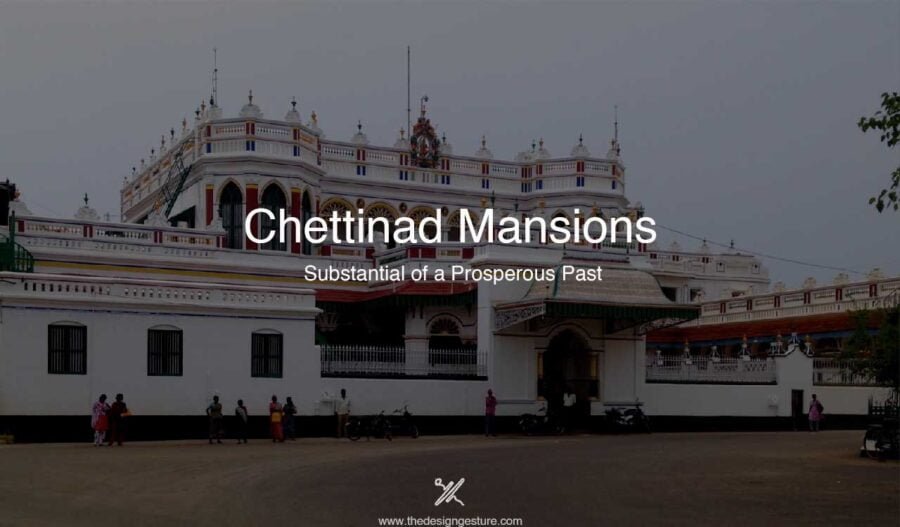Once an inseparable partner and witness in the lives of the Natukottai Chettiars, their lifestyle, rituals, and customs, over 10,000 palatial Chettinad Mansions now suffer desolation in the ghosted towns of the Chettinad Region. With around one-fifth of the mansions wiped off, the remaining are either awaiting demolition or renovation, while a small percentage of the mansions are retrofitted or repurposed. This article explores the eclectic residential units, their emergence, and their role in the lives of the Chettiar community.
Table of Contents
Dissecting the Chettinad Region
Chettinad is not a district or town, it is a region spreading over 1550 square kilometers located in the Indian state of Tamilnadu near Madurai, where the ‘Nattukottai Chettairs’ settled after migrating from the tsunami-hit coastal region of Tamilnadu. Hence, Chettinad has no defined boundaries, and is a cluster of 73 villages that exist out of the 96 villages, according to the Maniyadi Sastram texts. The Chettinad region in the Pudukottai and Sivagangai districts is bound by Pudukottai in the North, Aranthangi in the East, Devakottai in the South, and Tirupathur in the West.
The significant village clusters of the Chettinad region include the clusters of Kanadukathan, Pallathur, Kottaiyur, and Kothamangalam of the Sivaganagai District, following Karaikudi, Kandanur, Athangudi, and Chokalingampudur, also in the District of Sivaganga, and finally the cluster of villages Rayavaram, Kadiapatti and Arimalam in the District of Pudukottai, inscribed in the tentative list of UNESCO.
Since their occupation, the Chettiar community has shaped the urban fabric and water management systems of the arid hinterland avidly with a coalescence of Western and Tamil urban planning and water management principles. The villages followed an orthogonal urban grid pattern along the east-west and north-south directions with the main streets in the North-South direction and the secondary streets in the East-West direction which influenced the layout of the palatial Chettinad houses. Inspired by local agricultural water harvesting techniques, they have developed an interconnected system of management of ponds locally known as ooranis and traditional surface water storage reservoirs erys or Kanmois.
Chettinad Mansions: The Story of its Development
The Chettiars belonged to a wealthy clan of merchants and financiers who were involved in trade, often set sail across the seas, and accumulated wealth. Until the late 19th century, their residential units were simple, bilaterally symmetrical, and single-storied with pitched roofs and clay tiles. Once their trade flourished in the late 19th century and 20th century, they acquired surplus wealth setting up businesses in Southeast Asia, which had a significant impact on the architecture of their houses and led to the birth of palatial Chettinad mansions as their residences.
These palatial residential units are a blend of European and Indian styles, often built with imported materials due to the profession of trading of the Chettiars, and the nature of their work that involves traveling and exposure to foreign styles of construction and materials. Subsequently, these mansions with improved plans, monumental facades, raised height, multiple levels of balustrades, doubled colonnades and loggias became an exhibit of wealth the owner possessed.
These mansions are huge, spanning across an entire street, spread over an area of at least 20,000 square feet to 70,000 square feet, often comprising more than 50 rooms, and three to four courtyards were built between 1840 and 1935. However, these mansions not only demonstrated the wealth of the Chettiar community and their extensive travel to foreign countries but also served as testimonies to rituals and living traditions of the Chettiar community from birth till demise. These mansions were designed so, to serve as wedding halls, spaces to celebrate religious events, etc. in addition to being a home.
Spatial Layout and Key Components
Due to the orthogonal grid of the villages in the Chettinad region, the Chettinad houses assumed an East-West orientation longitudinally, which also aided in making the houses climate-responsive. The houses were planned on the motto of ‘form follows function’ and with the different genders and their privacy in mind. The plan reflects a gradation in privacy descending from the rear to the front entrance along the longitudinal axis.
The four main sections of the house are Mugappu, the entrance hall with Thinnai, built-in seating for guests, followed by Valavu, the main living hall embodying the Nadu Vaasal, or the main or central courtyard, then the Irandan Kattu that comprises the dining area and Moonran Kattu which represent the typical Chettinad kitchen.
The section near the entrance is occupied by the male members, while that of the mid-region by women and children, and the rear end is occupied by servants and chefs. Hence it is precise that though the exterior of the mansions with Gothic facades, marble, stained glass windows, and tiles from Europe and the traditional Indian courtyards, raised verandas, richly carved wooden frames, and stucco reliefs depicting Hindu deities, portray a blend of European and traditional architectural styles, the space planning and interior is responsive to indigenous customs and traditions.
Constructional Nuances and Building Materials of Chettinad Mansions
Chettinad mansions are an abode of imported materials including Burma teak wood, Ceylon satinwood, Belgian glass, Venetian tiles, Italian marble, English steel and cast iron and European chandeliers and Indian expertise for woodcarving, frescoes, and egg-plastering. During the 1930s and 1940s, Art Deco, Art Nouveau, and Neoclassical elements surfaced in the front facades of the mansions exemplified in the arches, grills, gates, and stained glass paneling.
Apart from these imported materials, Chettinad mansions are known for the use of chettinad tiles. Chettinad tiles unlike foreign materials are locally made in the village of Athangudi in the Chettinad region. The chettinad tiles are made from locally extracted clay that has been burned, glazed and efficiently crafted into tiles of various patterns and colors. These tiles adorn the floors and walls of the mansions.
The colonnades surrounding the courtyard depicted a variety of intricate detailing and craftsmanship from extravagant, highly ornate, polished, Italian marble columns, polished local granite to highly carved monolithic timber columns in the public spaces forefront in juxtaposition with economical, unpolished, unembellished rudimentary granite columns in the service sections like monogram kattu and backyard.
Climate Responsive Features
Considering the hot and arid climate of the Chettinad region, the Chettinad mansions were designed with an ample number of courtyards facilitating ventilation, passive cooling, and accumulating surplus daylight. The longitudinal East-West orientation further enhanced the courtyard effect. Further, the sloped roofs helped collect rainwater during monsoon and fed it into the urban water management system, to combat the scarcity of water during summer, given the arid climate of the region. Besides, the passive design strategies, orientation, courtyards, and sloping roofs, the materials chosen for construction, also responded to the climate including thick brick walls enhanced with lime plasters, multiple layers of terracotta tiles roofing, marble and stone flooring due to their high thermal mass.
Chettinad Mansions: Substantial of a Prosperous Past
The Chettinad Palatial houses are a fusion of local architectural elements like courtyards, raised verandas, richly carved wooden frames, and stucco reliefs depicting Hindu gods and goddesses and the foreign influences visible in the exterior of the mansions with Gothic facades, marble, and stained glass windows signifying the business history of the trade of the Chettiar community, and the community’s stronghold of intangible traditions and customs. These Chettinad mansions of immense architectural value are also ancestral homes habited over decades, the center point of all family events and inevitable in special moments including birth, festivals, marriages, and engagement ceremonies.
Even, today ancestral homes are used as wedding venues, one of the significant reasons for the upkeep and maintenance of decades-old houses as identified by researchers. Not just the Chettinad mansions, the Chettinad village clusters as a whole reflect the prosperous past, progressive urban planning principles, and the still living customs and traditions of the Chettiar community. The Chettinad mansions are simply a testimony to the fact that culture shapes architecture.
FAQ
- What are the nine nagara temples of the Chettnad?
The nine Nagara temples of the Chettinad are Illayathakudi, Illupaikudi, Iraniyur, Mattur, Nemam, Pillaiyarpatti, Soraikudi, Vairavanpatti, and Velankudi, each managed by its own clan committee and belonging to the Chettiar community, which has preserved its unique culture in the region.
- What are the notable institutes in Chettinad?
Karaikudi, the principal town of Chettinad, is home to several notable institutions, including the Central Electro Chemical Research Institute (CECRI), a national laboratory under the Council of Scientific and Industrial Research (CSIR), and Alagappa University, a public university established in 1985 by the Tamil Nadu government, which originated from Alagappa Arts College founded by Alagappa Chettiar in 1947.




